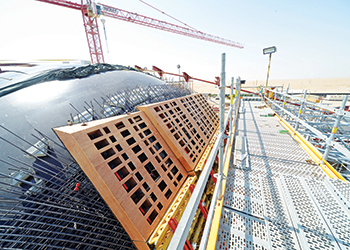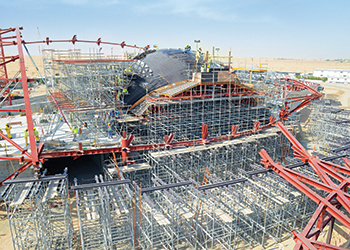Peri gives form to Bee’ah HQ
01 October 2017
Following its success in helping shape the unique Sheikh Zayed Desert Learning Centre in Al Ain, German formwork expert Peri has been appointed by the contractor Al Futtaim-Carillion to provide formwork solutions for yet another futuristic development – Bee’ah’s new headquarters in Sharjah.
Located in the middle of the desert, a new 7,000-sq-m headquarters of the Sharjah-based integrated environmental and waste management company is being built adjacent to its existing waste management centre in the UAE emirate. Based on a design by renowned Zaha Hadid Architects, the curves of the building resemble a series of sand dunes with ever-changing geometries. Once opened to the public, the Leed (Leadership in Energy and Environmental Design) Platinum-seeking project will also serve as a learning centre to promote environmental awareness and will be run using renewable energy sources produced entirely at site.
Peri was selected by Al Futtaim-Carillion based on its earlier success on the Sheikh Zayed Desert Learning Centre in Al Ain, because of its strong engineering expertise in 3D formwork.
 |
|
|
“The central design feature of the building is the entrance lobby dome that consists of two primary dunes, which will later house the public and administrative section. This dome is a central design feature of the project. Its complex geometry contains embedded metal light boxes and is specified to be constructed from natural concrete to preserve an eco-friendly aspect,” said a spokesperson for Peri.
Peri supplied individually unique formwork panels, based on the proven Vario GT 24 system and supported by the modular Peri Up scaffold system. Every panel is different in shape, having no symmetry to each other. By providing comprehensive on-site support, using highest quality Wisa plywood and meticulously pre-assembling the panels at its 75,000-sq-m logistics facility in Dubai, Peri ensured that it fully met the architects’ high requirements for an ‘as struck’ fair-faced concrete finish with very low tolerances regarding standards on a uniform pattern of the plywood joints, screw head imprints and tie holes, he explained.
“This unique project will be later featured in a standalone documentary on the National Geographic channel, which visits the site every month to document the technology used and progress achieved at this very particular construction site,” the spokesperson added.
- Waterfront homes snapped up
- Acwa consortium wins $3.8bn solar project
- Peri gives form to Bee’ah HQ
- New tower takes the shape of ‘U’
- $816m Sharjah community on way
- Louvre Abu Dhabi poised to open doors
- UAE active projects hit $228bn
- Azizi reveals Meydan ambitions
- Creek to get $599m wellness resort
- In brief
- District One to get luxury apartments
- Araco wins residential deal
- Consultant named for Makers District
- $1.2bn Al Ain hospital 50pc complete



